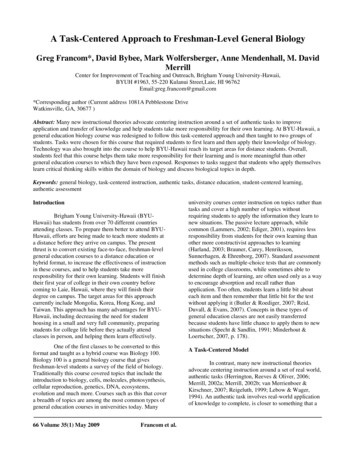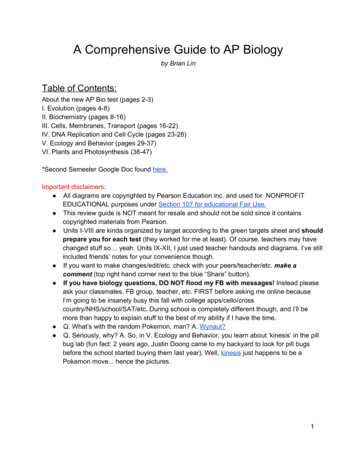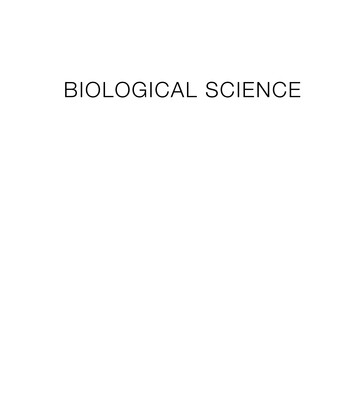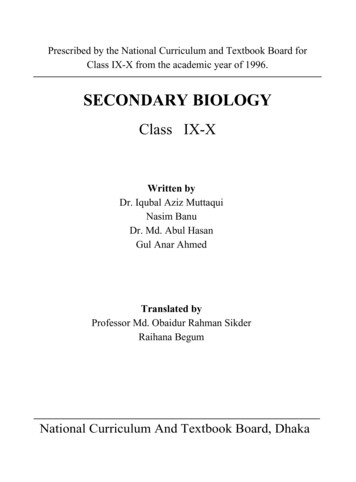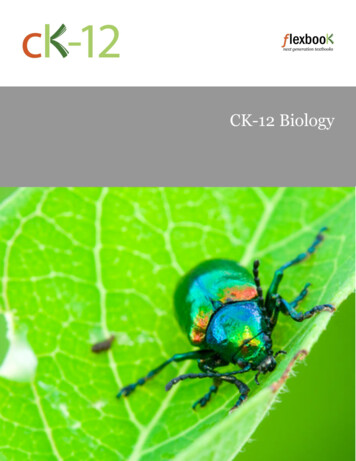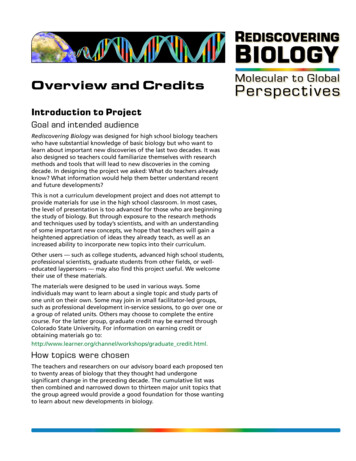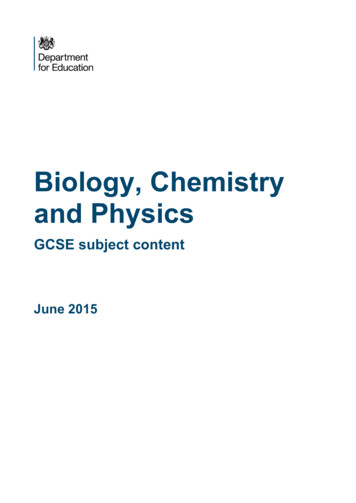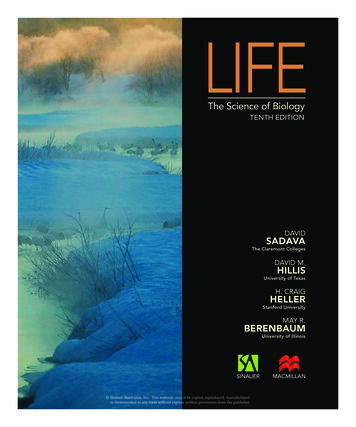
Transcription
LIFEThe Science of BiologyTENTH EDITIONDAVIDSADAVAThe Claremont CollegesDAVID M.HILLISUniversity of TexasH. CRAIGHELLERStanford UniversityMAY R.BERENBAUMUniversity of IllinoisSINAUER Sinauer Associates, Inc. This material cannot be copied, reproduced, manufacturedor disseminated in any form without express written permission from the publisher.MACMILLAN
Contents in BriefPART ONE THE SCIENCE OF LIFE AND ITS1234CHEMICAL BASISStudying Life 1Small Molecules and the Chemistry of Life 21Proteins, Carbohydrates, and Lipids 39Nucleic Acids and the Origin of Life 62PART TWO CELLS5 Cells: The Working Units of Life 776 Cell Membranes 1057 Cell Communication and Multicellularity 125PART THREE CELLS AND ENERGY8 Energy, Enzymes, and Metabolism 1449 Pathways that Harvest Chemical Energy 16510 Photosynthesis: Energy from Sunlight 185PART FOUR GENES AND HEREDITY111213141516The Cell Cycle and Cell Division 205Inheritance, Genes, and Chromosomes 232DNA and Its Role in Heredity 259From DNA to Protein: Gene Expression 281Gene Mutation and Molecular Medicine 304Regulation of Gene Expression 328PART FIVE GENOMES17181920Genomes 352Recombinant DNA and Biotechnology 373Differential Gene Expression in Development 392Genes, Development, and Evolution 412PART SIX THE PATTERNS AND PROCESSES2122232425OF EVOLUTIONMechanisms of Evolution 427Reconstructing and Using Phylogenies 449Speciation 467Evolution of Genes and Genomes 485The History of Life on Earth 505PART SEVEN THE EVOLUTION OF DIVERSITY26 Bacteria, Archaea, and Viruses 52527 The Origin and Diversification of Eukaryotes 54928 Plants without Seeds: From Water to Land 5692930313233The Evolution of Seed Plants 588The Evolution and Diversity of Fungi 608Animal Origins and the Evolution of Body Plans 629Protostome Animals 651Deuterostome Animals 678PART EIGHT FLOWERING PLANTS:343536373839FORM AND FUNCTIONThe Plant Body 708Transport in Plants 726Plant Nutrition 740Regulation of Plant Growth 756Reproduction in Flowering Plants 778Plant Responses to Environmental Challenges 797PART NINE ANIMALS:FORM AND FUNCTION40 Physiology, Homeostasis, and TemperatureRegulation 81541 Animal Hormones 83442 Immunology: Animal Defense Systems 85643 Animal Reproduction 88044 Animal Development 90245 Neurons, Glia, and Nervous Systems 92446 Sensory Systems 94647 The Mammalian Nervous System 96748 Musculoskeletal Systems 98649 Gas Exchange 100550 Circulatory Systems 102551 Nutrition, Digestion, and Absorption 104852 Salt and Water Balance and NitrogenExcretion 107153 Animal Behavior 1093PART TEN ECOLOGY545556575859Ecology and the Distribution of Life 1121Population Ecology 1149Species Interactions and Coevolution 1169Community Ecology 1188Ecosystems and Global Ecology 1207Biodiversity and Conservation Biology 1228 Sinauer Associates, Inc. This material cannot be copied, reproduced, manufacturedor disseminated in any form without express written permission from the publisher.
ContentsPART ONEThe Science of Life and ItsChemical Basis1Studying Life 11.1 What Is Biology? 2Life arose from non-life via chemicalevolution 3Cellular structure evolved in thecommon ancestor of life 3Photosynthesis allows someorganisms to capture energyfrom the sun 4Biological information is containedin a genetic language commonto all organisms 5Populations of all living organismsevolve 6Biologists can trace theevolutionary tree of life 6Cellular specialization anddifferentiation underliemulticellular life 9Living organisms interact with oneanother 9Nutrients supply energy and arethe basis of biosynthesis 10Living organisms must regulatetheir internal environment 101.2 How Do BiologistsInvestigate Life? 11Observing and quantifying areimportant skills 11Scientific methods combineobservation, experimentation,and logic 11Good experiments have thepotential to falsifyhypotheses 12Statistical methods are essentialscientific tools 13Discoveries in biology can begeneralized 14Not all forms of inquiry arescientific 141.3 Why Does Biology Matter?15Modern agriculture depends onbiology 15Biology is the basis of medicalpractice 15Biology can inform public policy 16Biology is crucial for understandingecosystems 17Biology helps us understand andappreciate biodiversity 172Small Moleculesand the Chemistryof Life 21Hydrophobic interactions bringtogether nonpolarmolecules 30van der Waals forces involvecontacts between atoms 302.3 How Do Atoms ChangePartners in ChemicalReactions? 312.4 What Makes Water SoImportant for Life? 32Water has a unique structure andspecial properties 32The reactions of life take place inaqueous solutions 33Aqueous solutions may be acidic orbasic 342.1 How Does Atomic StructureExplain the Properties ofMatter? 22An element consists of only onekind of atom 22Each element has a unique numberof protons 22The number of neutrons differsamong isotopes 22The behavior of electronsdetermines chemical bondingand geometry 242.2 How Do Atoms Bond toForm Molecules? 26Covalent bonds consist of sharedpairs of electrons 26Ionic attractions form by electricalattraction 28Hydrogen bonds may form withinor between molecules with polarcovalent bonds 30Proteins,Carbohydrates,and Lipids 3933.1 What Kinds of MoleculesCharacterize LivingThings? 40Functional groups give specificproperties to biologicalmolecules 40Isomers have differentarrangements of the sameatoms 41The structures of macromoleculesreflect their functions 41 Sinauer Associates, Inc. This material cannot be copied, reproduced, manufacturedor disseminated in any form without express written permission from the publisher.
XXIIContentsMost macromolecules are formedby condensation and brokendown by hydrolysis 42Monosaccharides are simplesugars 52Glycosidic linkages bondmonosaccharides 53Polysaccharides store energy andprovide structural materials 53Chemically modified carbohydratescontain additional functionalgroups 553.2 What Are the ChemicalStructures and Functions ofProteins? 42Amino acids are the building blocksof proteins 43Peptide linkages form thebackbone of a protein 43The primary structure of a proteinis its amino acid sequence 45The secondary structure of aprotein requires hydrogenbonding 45The tertiary structure of a protein isformed by bending andfolding 46The quaternary structure of aprotein consists of subunits 48Shape and surface chemistrycontribute to proteinfunction 48Environmental conditions affectprotein structure 50Protein shapes can change 50Molecular chaperones help shapeproteins 513.3 What Are the ChemicalStructures and Functions ofCarbohydrates? 513.4 What Are the ChemicalStructures and Functions ofLipids? 56Fats and oils are triglycerides 56Phospholipids form biologicalmembranes 57Some lipids have roles in energyconversion, regulation, andprotection 574Nucleic Acidsand the Origin ofLife 624.1 What Are the ChemicalStructures and Functions ofNucleic Acids? 63Nucleotides are the building blocksof nucleic acids 63Base pairing occurs in both DNAand RNA 63DNA carries information and isexpressed through RNA 65The DNA base sequence revealsevolutionary relationships 66Nucleotides have other importantroles 664.2 How and Where Did theSmall Molecules of LifeOriginate? 67Experiments disproved thespontaneous generation oflife 67Life began in water 68Life may have come from outsideEarth 69Prebiotic synthesis experimentsmodel early Earth 694.3 How Did the LargeMolecules of LifeOriginate? 71Chemical evolution may have led topolymerization 71RNA may have been the firstbiological catalyst 714.4 How Did the First CellsOriginate? 71Experiments explore the origin ofcells 73Some ancient cells left a fossilimprint 74PART TWO Cells5Cells: The WorkingUnits of Life 775.1 What Features Make Cellsthe Fundamental Units ofLife? 78Cell size is limited by the surfacearea-to-volume ratio 78Microscopes reveal the features ofcells 79The plasma membrane forms theouter surface of every cell 79Cells are classified as eitherprokaryotic or eukaryotic 815.2 What Features CharacterizeProkaryotic Cells? 82Prokaryotic cells share certainfeatures 82Specialized features are found insome prokaryotes 835.3 What Features CharacterizeEukaryotic Cells? 84Compartmentalization is the key toeukaryotic cell function 84Organelles can be studied bymicroscopy or isolated forchemical analysis 84Ribosomes are factories for proteinsynthesis 84The nucleus contains most of thegeneric information 85The endomembrane system is agroup of interrelatedorganelles 88Some organelles transformenergy 91There are several othermembrane-enclosedorganelles 93The cytoskeleton is important incell structure andmovement 94Biologists can manipulate livingsystems to establish cause andeffect 98The extracellular matrix supportstissue functions in animals 1005.5 How Did Eukaryotic CellsOriginate? 101Internal membranes and thenuclear envelope probably camefrom the plasmamembrane 101Some organelles arose byendosymbiosis 1025.4 What Are the Roles ofExtracellularStructures? 99The plant cell wall is anextracellular structure 99 Sinauer Associates, Inc. This material cannot be copied, reproduced, manufacturedor disseminated in any form without express written permission from the publisher.
Contents XXIII6CellMembranes 105A signal transduction pathwayinvolves a signal, a receptor, andresponses 1267.2 How Do Signal ReceptorsInitiate a CellularResponse? 1276.1 What Is the Structure of aBiological Membrane? 106Lipids form the hydrophobic coreof the membrane 106Membrane proteins areasymmetrically distributed 107Membranes are constantlychanging 109Plasma membrane carbohydratesare recognition sites 109Receptors that recognize chemicalsignals have specific bindingsites 127Receptors can be classified bylocation and function 128Intracellular receptors are locatedin the cytoplasm or thenucleus 1306.2 How Is the PlasmaMembrane Involved in CellAdhesion andRecognition? 110Cell recognition and adhesioninvolve proteins andcarbohydrates at the cellsurface 111Three types of cell junctionsconnect adjacent cells 111Cell membranes adhere to theextracellular matrix 111Different energy sources distinguishdifferent active transportsystems 1186.5 How Do Large MoleculesEnter and Leave aCell? 1206.3 What Are the PassiveProcesses of MembraneTransport? 113Diffusion is the process of randommovement toward a state ofequilibrium 113Simple diffusion takes placethrough the phospholipidbilayer 114Osmosis is the diffusion of wateracross membranes 114Diffusion may be aided by channelproteins 115Carrier proteins aid diffusion bybinding substances 1176.4 What are the ActiveProcesses of MembraneTransport? 118Active transport is directional7.3 How Is the Response to aSignal Transduced throughthe Cell? 131118Macromolecules and particles enterthe cell by endocytosis 120Receptor-mediated endocytosis ishighly specific 121Exocytosis moves materials out ofthe cell 1227Cell Communicationand Multicellularity1257.1 What Are Signals, and HowDo Cells Respond toThem? 126Cells receive signals from thephysical environment and fromother cells 126A protein kinase cascade amplifiesa response to ligandbinding 131Second messengers can amplifysignals between receptors andtarget molecules 132Signal transduction is highlyregulated 1367.4 How Do Cells Change inResponse to Signals? 137Ion channels open in response tosignals 137Enzyme activities change inresponse to signals 138Signals can initiate DNAtranscription 1397.5 How Do Cells in aMulticellular OrganismCommunicateDirectly? 139Animal cells communicate throughgap junctions 139Plant cells communicate throughplasmodesmata 140Modern organisms provide cluesabout the evolution of cell–cellinteractions andmulticellularity 140PART THREECells and Energy8Energy, Enzymes,and Metabolism1448.1 What Physical PrinciplesUnderlie Biological EnergyTransformations? 145There are two basic types ofenergy 145There are two basic types ofmetabolism 145The first law of thermodynamics:Energy is neither created nordestroyed 146The second law ofthermodynamics: Disorder tendsto increase 146Chemical reactions release orconsume energy 147Chemical equilibrium and freeenergy are related 1488.2 What Is the Role of ATPin BiochemicalEnergetics? 149ATP hydrolysis releasesenergy 149 Sinauer Associates, Inc. This material cannot be copied, reproduced, manufacturedor disseminated in any form without express written permission from the publisher.
XXIVContentsATP couples exergonic andendergonic reactions 1508.3 What Are Enzymes? 1519.2 What Are the AerobicPathways of GlucoseCatabolism? 169In glycolysis, glucose is partiallyoxidized and some energy isreleased 169Pyruvate oxidation links glycolysisand the citric acid cycle 170The citric acid cycle completesthe oxidation of glucose toCO2 170Pyruvate oxidation and the citricacid cycle are regulated by theconcentrations of startingmaterials 171To speed up a reaction, an energybarrier must be overcome 151Enzymes bind specific reactants attheir active sites 152Enzymes lower the energy barrierbut do not affectequilibrium 1538.4 How Do EnzymesWork? 154Enzymes can orientsubstrates 154Enzymes can induce strain in thesubstrate 154Enzymes can temporarily addchemical groups tosubstrates 154Molecular structure determinesenzyme function 155Some enzymes require othermolecules in order tofunction 155The substrate concentration affectsthe reaction rate 1568.5 How Are Enzyme ActivitiesRegulated? 156Enzymes can be regulated byinhibitors 157Allosteric enzymes are controlledvia changes in shape 159Allosteric effects regulate manymetabolic pathways 160Many enzymes are regulatedthrough reversiblephosphorylation 161Enzymes are affected by theirenvironment 16199.3 How Does OxidativePhosphorylation FormATP? 171The respiratory chain transferselectrons and protons, andreleases energy 172Proton diffusion is coupled to ATPsynthesis 173Some microorganisms use non-O2electron acceptors 1769.4 How Is Energy Harvestedfrom Glucose in the Absenceof Oxygen? 177Cellular respiration yieldsmuch more energy thanfermentation 178The yield of ATP is reduced by theimpermeability of mitochondriato NADH 1789.5 How Are MetabolicPathways Interrelated andRegulated? 179Cells trap free energy whilemetabolizing glucose 166Redox reactions transfer electronsand energy 167The coenzyme NAD is a keyelectron carrier in redoxreactions 167An overview: Harvesting energyfrom glucose 168Light energy is absorbed bychlorophyll and otherpigments 188Light absorption results inphotochemical change 190Reduction leads to ATP andNADPH formation 191Chemiosmosis is the source ofthe ATP produced inphotophosphorylation 19210.3 How Is Chemical EnergyUsed to SynthesizeCarbohydrates? 193Radioisotope labelingexperiments revealed the stepsof the Calvin cycle 193The Calvin cycle is made up ofthree processes 194Light stimulates the Calvincycle 19610.4 How Have Plants AdaptedPhotosynthesis toEnvironmentalConditions? 197Rubisco catalyzes the reaction ofRuBP with O2 or CO2 197C3 plants undergophotorespiration but C4 plantsdo not 198CAM plants also use PEPcarboxylase 20010.5 How Does PhotosynthesisInteract with OtherPathways? 200Catabolism and anabolism arelinked 179Catabolism and anabolism areintegrated 180Metabolic pathways are regulatedsystems 181Pathways ThatHarvest ChemicalEnergy 1659.1 How Does GlucoseOxidation Release ChemicalEnergy? 16610.2 How Does PhotosynthesisConvert Light Energy intoChemical Energy? 18810Photosynthesis:Energy fromSunlight 18510.1 What Is Photosynthesis186Experiments with isotopesshow that O2 comes from H2Oin oxygenicphotosynthesis 186Photosynthesis involves twopathways 188 Sinauer Associates, Inc. This material cannot be copied, reproduced, manufacturedor disseminated in any form without express written permission from the publisher.
Contents XXVPART FOURGenes and Heredity11The Cell Cycle andCell Division 20511.1 How Do Prokaryotic andEukaryotic CellsDivide? 206Prokaryotes divide by binaryfission 206Eukaryotic cells divide by mitosisor meiosis followed bycytokinesis 207The number, shapes, and sizes ofthe metaphase chromosomesconstitute the karyotype 224Polyploids have more than twocomplete sets of chromosomes22411.6 In a Living Organism,How Do Cells Die? 22511.7 How Does UnregulatedCell Division Lead toCancer? 227Cancer cells differ from normalcells 227Cancer cells lose control over thecell cycle and apoptosis 228Cancer treatments target the cellcycle 22811.2 How Is Eukaryotic CellDivision Controlled? 208Specific internal signals triggerevents in the cell cycle 208Growth factors can stimulate cellsto divide 21111.3 What Happens duringMitosis? 211Prior to mitosis, eukaryotic DNAis packed into very compactchromosomes 211Overview: Mitosis segregatescopies of geneticinformation 212The centrosomes determine theplane of cell division 212The spindle begins to formduring prophase 213Chromosome separation andmovement are highlyorganized 214Cytokinesis is the division of thecytoplasm 21611.4 What Role Does CellDivision Play in a SexualLife Cycle? 217Asexual reproduction by mitosisresults in geneticconstancy 217Sexual reproduction by meiosisresults in geneticdiversity 21811.5 What Happens duringMeiosis? 219Meiotic division reduces thechromosome number 219Chromatid exchanges duringmeiosis I generate geneticdiversity 219During meiosis homologouschromosomes separate byindependent assortment 220Meiotic errors lead to abnormalchromosome structures andnumbers 22212Inheritance, Genes,and Chromosomes23212.3 How Do GenesInteract? 244Hybrid vigor results from newgene combinations andinteractions 244The environment affects geneaction 245Most complex phenotypes aredetermined by multiple genesand the environment 24612.1 What Are the MendelianLaws of Inheritance? 233Mendel used the scientificmethod to test hishypotheses 233Mendel’s first experimentsinvolved monohybridcrosses 234Mendel’s first law states that thetwo copies of a genesegregate 236Mendel verified his hypothesesby performing testcrosses 237Mendel’s second law states thatcopies of different genes assortindependently 237Probability can be used to predictinheritance 239Mendel’s laws can be observed inhuman pedigrees 24012.4 What Is the Relationshipbetween Genes andChromosomes? 247Genes on the same chromosomeare linked 247Genes can be exchangedbetween chromatids andmapped 247Linkage is revealed by studies ofthe sex chromosomes 24912.5 What Are the Effects ofGenes Outside theNucleus? 25212.6 How Do ProkaryotesTransmit Genes? 253Bacteria exchange genes byconjugation 253Bacterial conjugation is controlledby plasmids 25412.2 How Do Alleles Interact?241New alleles arise bymutation 241Many genes have multiplealleles 242Dominance is not alwayscomplete 242In codominance, both alleles at alocus are expressed 243Some alleles have multiplephenotypic effects 24313DNA and Its Rolein Heredity 25913.1 What Is the Evidence thatthe Gene Is DNA? 260 Sinauer Associates, Inc. This material cannot be copied, reproduced, manufacturedor disseminated in any form without express written permission from the publisher.DNA from one type of bacteriumgenetically transforms anothertype 260
XXVIContentsViral infection experimentsconfirmed that DNA is thegenetic material 261Eukaryotic cells can also begenetically transformed byDNA 26313.2 What Is the Structure ofDNA? 264Watson and Crick used modelingto deduce the structure ofDNA 264Four key features define DNAstructure 265The double-helical structure ofDNA is essential to itsfunction 26613.3 How Is DNAReplicated? 267Three modes of DNA replicationappeared possible 267An elegant experimentdemonstrated thatDNA replication issemiconservative 268There are two steps inDNA replication 268DNA polymerases addnucleotides to the growingchain 269Many other proteins assist withDNA polymerization 272The two DNA strands growdifferently at the replicationfork 272Telomeres are not fully replicatedand are prone to repair 27513.4 How Are Errors in DNARepaired? 27613.5 How Does the PolymeraseChain Reaction AmplifyDNA? 277The polymerase chain reactionmakes multiple copies of DNAsequences 27714From DNA toProtein: GeneExpression 28114.1 What Is the Evidence thatGenes Code forProteins? 282One gene determines onepolypeptide 28314.2 How Does InformationFlow from Genes toProteins? 284Three types of RNA have roles inthe information flow from DNAto protein 285In some cases, RNA determinesthe sequence of DNA 28514.3 How Is the InformationContent in DNATranscribed to ProduceRNA? 286RNA polymerases share commonfeatures 286Transcription occurs in threesteps 286The information for proteinsynthesis lies in the geneticcode 28814.4 How Is Eukaryotic DNATranscribed and the RNAProcessed? 290Many eukaryotic genes areinterrupted by noncodingsequences 290Eukaryotic gene transcripts areprocessed beforetranslation 29114.5 How Is RNA Translated intoProteins? 293Transfer RNAs carry specificamino acids and bind tospecific codons 293Each tRNA is specifically attachedto an amino acid 294The ribosome is the workbenchfor translation 294Translation takes place in threesteps 295Polysome formation increases therate of protein synthesis 29715Gene Mutationand MolecularMedicine 30415.1 What Are Mutations? 305Mutations have differentphenotypic effects 305Point mutations are changes insingle nucleotides 306Chromosomal mutations areextensive changes in thegenetic material 307Retroviruses and transposons cancause loss of functionmutations or duplications 308Mutations can be spontaneous orinduced 308Mutagens can be natural orartificial 310Some base pairs are morevulnerable than others tomutation 310Mutations have both benefits andcosts 31015.2 What Kinds of MutationsLead to Genetic Diseases?311Genetic mutations may makeproteins dysfunctional 311Disease-causing mutations mayinvolve any number of basepairs 312Expanding triplet repeatsdemonstrate the fragility ofsome human genes 313Cancer often involves somaticmutations 31414.6 What Happens toPolypeptides afterTranslation? 298Signal sequences in proteinsdirect them to their cellulardestinations 298Many proteins are modified aftertranslation 300Observations in humans led tothe proposal that genesdetermine enzymes 282Experiments on bread moldestablished that genesdetermine enzymes 282 Sinauer Associates, Inc. This material cannot be copied, reproduced, manufacturedor disseminated in any form without express written permission from the publisher.
Contents XXVIIMost diseases are caused bymultiple genes andenvironment 31415.3 How Are MutationsDetected and Analyzed?315Restriction enzymes cleave DNAat specific sequences 315Gel electrophoresis separatesDNA fragments 316DNA fingerprinting combinesPCR with restriction analysisand electrophoresis 317Reverse genetics can be used toidentify mutations that lead todisease 318Genetic markers can be used tofind disease-causinggenes 318The DNA barcode project aims toidentify all organisms onEarth 31915.4 How Is Genetic ScreeningUsed to DetectDiseases? 320Screening for disease phenotypesinvolves analysis of proteinsand other chemicals 320DNA testing is the most accurateway to detect abnormalgenes 320Allele-specific oligonucleotidehybridization can detectmutations 32115.5 How Are Genetic DiseasesTreated? 322Genetic diseases can be treatedby modifying thephenotype 322Gene therapy offers the hope ofspecific treatments 32316Regulation of GeneExpression 32816.1 How Is Gene ExpressionRegulated inProkaryotes? 329Regulating gene transcriptionconserves energy 329Operons are units oftranscriptional regulation inprokaryotes 330Operator–repressor interactionscontrol transcription in the lacand trp operons 330Protein synthesis can becontrolled by increasingpromoter efficiency 332RNA polymerases can be directedto particular classes ofpromoters 33216.2 How Is Eukaryotic GeneTranscription Regulated?333General transcription factors actat eukaryotic promoters 333Specific proteins can recognizeand bind to DNA sequencesand regulate transcription335Specific protein–DNA interactionsunderlie binding 335The expression of transcriptionfactors underlies celldifferentiation 336The expression of sets of genescan be coordinately regulatedby transcription factors 336Many bacteriophages undergo alytic cycle 339Some bacteriophages can undergoa lysogenic cycle 340Eukaryotic viruses can havecomplex life cycles 341HIV gene regulation occurs at thelevel of transcriptionelongation 34116.4 How Do EpigeneticChanges Regulate GeneExpression? 343DNA methylation occurs atpromoters and silencestranscription 343Histone protein modifications affecttranscription 344Epigenetic changes can be inducedby the environment 344DNA methylation can result ingenomic imprinting 344Global chromosome changesinvolve DNA methylation 34516.5 How Is Eukaryotic GeneExpression Regulated afterTranscription? 34616.3 How Do Viruses RegulateTheir GeneExpression? 339PART FIVEGenomes17Genomes 35217.1 How Are GenomesSequenced? 353New methods have beendeveloped to rapidly sequenceDNA 353Genome sequences yield severalkinds of information 35517.2 What Have We Learnedfrom SequencingProkaryotic Genomes? 356Prokaryotic genomes arecompact 356The sequencing of prokaryoticand viral genomes has manypotential benefits 357Metagenomics allows us todescribe new organisms andecosystems 357Some sequences of DNA canmove about the genome 358 Sinauer Associates, Inc. This material cannot be copied, reproduced, manufacturedor disseminated in any form without express written permission from the publisher.Different mRNAs can be madefrom the same gene byalternative splicing 346Small RNAs are importantregulators of geneexpression 347Translation of mRNA can beregulated by proteins andriboswitches 348
XXVIIIContentsWill defining the genes requiredfor cellular life lead to artificiallife? 35918.4 What Other Tools Are Usedto Study DNAFunction? 380Genes can be expressed indifferent biologicalsystems 380DNA mutations can be created inthe laboratory 381Genes can be inactivated byhomologousrecombination 381Complementary RNA can preventthe expression of specificgenes 382DNA microarrays reveal RNAexpression patterns 38217.3 What Have We Learnedfrom SequencingEukaryotic Genomes? 361Model organisms reveal manycharacteristics of eukaryoticgenomes 361Eukaryotes have genefamilies 363Eukaryotic genomes containmany repetitivesequences 36417.4 What Are theCharacteristics of theHuman Genome? 366The human genome sequenceheld some surprises 366Comparative genomics revealsthe evolution of the humangenome 366Human genomics has potentialbenefits in medicine 36718.5 What Is Biotechnology?383Expression vectors can turn cellsinto protein factories 384Medically useful proteins can bemade usingbiotechnology 384DNA manipulation is changingagriculture 386There is public concern aboutbiotechnology 388The proteome is more complexthan the genome 369Metabolomics is the study ofchemical phenotype 3701818.1 What Is RecombinantDNA? 37418.2 How Are New GenesInserted into Cells? 375Genes can be inserted intoprokaryotic or eukaryoticcells 376A variety of methods are used toinsert recombinant DNA intohost cells 376Reporter genes help select oridentify host cells containingrecombinant DNA 37718.3 What Sources of DNA AreUsed in Cloning? 379Libraries provide collections ofDNA fragments 379cDNA is made from mRNAtranscripts 379Synthetic DNA can be made byPCR or by organic chemistry38019.4 How Does GeneExpression DeterminePattern Formation? 399Multiple proteins interact todetermine developmentalprogrammed cell death 399Plants have organ identitygenes 400Morphogen gradients providepositional information 401A cascade of transcription factorsestablishes body segmentationin the fruit fly 40119.5 Is Cell DifferentiationReversible? 405Plant cells can be totipotent 405Nuclear transfer allows thecloning of animals 406Multipotent stem cellsdifferentiate in response toenvironmental signals 408Pluripotent stem cells can beobtained in two ways 40818.6 How Is BiotechnologyChanging Medicine andAgriculture? 38417.5 What Do the NewDisciplines of Proteomicsand MetabolomicsReveal? 369Recombinant DNAand Biotechnology373Differential gene transcription is ahallmark of celldifferentiation 39819Differential GeneExpression inDevelopment 39219.1 What Are the Processes ofDevelopment? 393Development involves distinct butoverlapping processes 393Cell fates become progressivelymore restricted duringdevelopment 39420Genes,Development, andEvolution 41220.1 How Can Small GeneticChanges Result in LargeChanges in Phenotype?413Developmental genes in distantlyrelated organisms aresimilar 41319.2 How Is Cell FateDetermined? 395Cytoplasmic segregation candetermine polarity and cell fate395Inducers passing from one cell toanother can determine cellfates 39519.3 What Is the Role of GeneExpression inDevelopment? 397Cell fate determination involvessignal transduction pathwaysthat lead to differential geneexpression 397 Sinauer Associates, Inc. This material cannot be copied, reproduced, manufacturedor disseminated in any form without express written permission from the publisher.
Contents XXIX20.2 How Can Mutations withLarge Effects Change OnlyOne Part of the Body? 415Genetic switches govern how thegenetic toolkit is used 415Modularity allows for differencesin the patterns of geneexpression 41620.3 How Can DevelopmentalChanges Result inDifferences amongSpecies? 418Differences in Hox geneexpression patterns result inmajor differences in bodyplans 418Mutations in developmentalgenes can produce majormorphological changes 41820.4 How Can the EnvironmentModulate Development?420Dietary information can be apredictor of futureconditions 421A variety of environmental signalsinfluence development 42120.5 How Do DevelopmentalGenes ConstrainEvolution? 423Evolution usually proceeds bychanging what’s alreadythere 423Conserved developmental genescan lead to parallelevolution 423Temperature can determinesex 420PART SIXThe Patterns and Processes of Evolution21Mechanisms ofEvolution 42721.1 What Is the Relationshipbetween Fact and Theoryin Evolution? 428Darwin and Wallace introduced theidea of evolution by naturalselection 428Evolutionary theory has continuedto develop over the pastcentu
The Science of Life and Its Chemical Basis Studying Life 1 1.1 What Is Biology? 2 Life arose from non-life via chemical evolution 3 Cellular structure evolved in the common ancestor of life 3 Photosynthesis allows some organisms to capture energy from the sun 4 Biological information is


